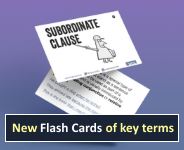Explanation
A function label for an element in the clause which typically comes after the verb phrase and before the Direct Object. The Indirect Object in a sentence is typically a noun phrase or pronoun that refers to someone or something that can be seen as the goal, recipient or beneficiary of the action expressed by the verb. For example, in We sent Kate some flowers the function of Indirect Object is filled by Kate. See also Object.Englicious contains many resources for English language in schools, but the vast majority of them require you to register and log in first. For more information, see What is Englicious?

